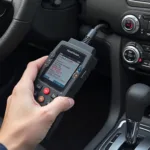OBD2 scanners and readers are essential tools for diagnosing car problems, but what’s the difference between an OBD2 scanner and reader? Many people use the terms interchangeably, but there are key distinctions that impact their functionality and what information they can provide. Understanding these differences is crucial for choosing the right tool for your needs, whether you’re a professional mechanic or a car enthusiast. Let’s dive in and clarify the difference between OBD2 scanners and readers. You can learn more about different types of OBD2 scan tools here: different types of obd2 scan tools.
What is an OBD2 Reader?
An OBD2 reader, also known as a code reader, is a basic diagnostic tool that retrieves diagnostic trouble codes (DTCs) from your vehicle’s onboard computer. Think of it as a simple translator, reading the error codes your car generates and displaying them for you. These codes indicate potential problems within your vehicle’s systems, such as the engine, transmission, or emissions control.
Basic Functions of an OBD2 Reader
- Reading DTCs: This is the primary function of an OBD2 reader. It identifies the codes stored in your car’s computer, providing a starting point for diagnosing issues.
- Clearing DTCs: After repairs, a reader can clear the codes, ensuring the check engine light turns off and the system is reset.
- Displaying Freeze Frame Data: This snapshot of the vehicle’s operating conditions when a fault code was stored can provide valuable diagnostic clues.
What is an OBD2 Scanner?
An OBD2 scanner is a more advanced diagnostic tool than a reader. While it can perform all the functions of a reader, it goes much further. A scanner provides in-depth access to your vehicle’s data stream, allowing you to monitor real-time sensor readings, perform tests, and even program certain modules.
Advanced Features of an OBD2 Scanner
- Live Data Streaming: Monitor real-time sensor readings, such as engine RPM, coolant temperature, and oxygen sensor voltage, to diagnose problems dynamically.
- Bi-directional Controls: Perform tests like activating fuel injectors, turning on cooling fans, or cycling ABS solenoids, to pinpoint faulty components.
- Advanced Diagnostics: Access manufacturer-specific codes and data, providing a deeper level of diagnostic information beyond generic OBD2 codes.
- Module Programming: Program or reprogram certain control modules, such as key fobs or powertrain control modules (PCMs), although this functionality is often limited to professional-grade scanners.
Key Differences: OBD2 Scanner vs. Reader
What are the difference of innova obd2 scanner? Innova scanners, for example, exemplify the capabilities of advanced diagnostic tools. They often offer features like ABS and airbag system diagnostics, in addition to standard OBD2 functionalities. This expanded capability illustrates the distinction between scanners and basic readers.
Functionality and Data Access
- Readers: Retrieve and clear generic OBD2 codes, display freeze frame data.
- Scanners: Offer all reader functions plus live data streaming, bi-directional controls, advanced diagnostics, and sometimes module programming.
Diagnostic Depth
- Readers: Provide a starting point for diagnosis by identifying basic fault codes.
- Scanners: Allow for in-depth diagnosis through real-time data monitoring and component testing.
Cost
- Readers: Generally more affordable, suitable for basic DIY diagnostics.
- Scanners: More expensive due to their advanced features and capabilities.
Which Tool Do You Need?
- DIYer/Car Enthusiast: An OBD2 reader is likely sufficient for checking and clearing basic codes, monitoring emissions readiness, and performing simple diagnostics.
- Professional Mechanic: An OBD2 scanner is essential for comprehensive diagnostics, advanced troubleshooting, and performing complex repairs. Check this resource for information about the 1999 Ford F250 Super Duty OBD2 system: 1999 ford f250 super duty obd2.
“Choosing the right diagnostic tool depends on your specific needs,” says automotive expert John Miller, ASE Certified Master Technician. “For casual users, a reader is often sufficient. However, professionals need the advanced capabilities of a scanner to effectively diagnose and repair modern vehicles.”
Why Understanding the Difference Matters
Understanding the difference between an OBD2 scanner and reader empowers you to make informed decisions about your car’s maintenance and repairs. You can find information related to OBD2 code 442 here: obd2 code 442. Whether you’re tackling a simple check engine light or investigating a complex drivability issue, having the right tool can save you time, money, and frustration.
Conclusion
The difference between an OBD2 scanner and reader boils down to functionality and diagnostic depth. While a reader provides basic code retrieval and clearing, a scanner offers a comprehensive suite of features for in-depth diagnostics and troubleshooting. Choosing the right tool depends on your needs and technical expertise.
FAQ
- Can a reader clear all types of codes? No, readers typically only clear generic OBD2 codes.
- Do I need a scanner to reset my check engine light? A reader can often reset the check engine light if the underlying issue has been addressed.
- Are all OBD2 scanners compatible with all car makes and models? Most scanners are compatible with standard OBD2 protocols, but some offer enhanced functionality for specific manufacturers.
- Can I use a scanner to perform advanced programming? Some professional-grade scanners offer limited programming capabilities, but not all.
- What is the average cost of an OBD2 reader? Readers typically range from $20 to $100.
- What is the average cost of an OBD2 scanner? Scanners can range from $100 to several thousand dollars depending on their features.
- How do I choose the right OBD2 tool for my needs? Consider your technical skills, diagnostic needs, and budget.
Need assistance? Contact us via WhatsApp: +1(641)206-8880, Email: [email protected] or visit us at 789 Elm Street, San Francisco, CA 94102, USA. We have a 24/7 customer support team ready to help.


